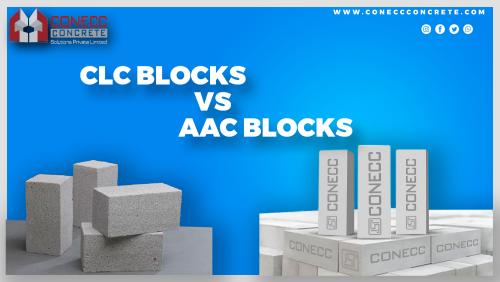AAC Vs CLC Blocks?
 AAC Vs CLC Blocks? Autoclaved Aerated Concrete (AAC Blocks) is a lightweight, load-bearing, high-insulating, long-lasting building product available in a variety of sizes and strengths. AAC blocks are lightweight, and when compared to red bricks, they are three to four times lighter. AAC blocks are lightweight construction materials. They are formed into masonry units or larger slabs and panels. Cellular Light Weight Blocks Concrete (CLC) is also known as Foam Concrete. Cellular Light Weight Concrete (CLC) is a type of lightweight concrete that is made in the same way as regular concrete under ambient conditions. CLC Blocks are a cement-bonded material created by blending cement slurry. To form foam concrete, the stable, pre-formed foam produced on-site is injected inside this slurry. Cellular lightweight concrete or foam concrete is used to make CLC blocks. Raw Materials of AAC and CLC Blocks AAC Blocks Lime, cement, gypsum, and an aeration agent are combined to create AAC blocks. At the same time, a small amount of fly ash is added to the mixture. CLC Blocks CLC Blocks are constructed with cement, fly ash slurry, water, as well as a foaming agent. CLC and AAC Block Price AAC Blocks Individual blocks are quite expensive, but the overall masonry cost is low due to the use of less mortar. When compared to red bricks, fewer AAC blocks are required for the same dimension. AAC blocks are less expensive than red bricks. It increases carpet area while decreasing built-up area. It also saves money on steel. CLC Blocks They are less expensive than ACC blocks. Individual blocks are more expensive, but overall masonry costs are lower because less mortar is required. For the same wall dimensions, smaller CLC blocks are required. CLC and AAC Block Sizes AAC Blocks Standard sizes available, varies according to the manufacturer: (600x200x100-300) (400x200x100-200) (230x115x75) CLC Blocks Standard sizes available in the market: Length: 400, 500 or 600 mm. Height: 200, 250 or 300 mm. Width: 100, 150, 200 or 250 mm. CLC and AAC Block Environmental Benefits AAC Blocks The waste generated during the manufacturing of AAC blocks can be recycled and reused. This waste is generated during the cutting process. A lower amount of CO2 is emitted during the manufacturing process. Small amounts of Fly ash is used in the production of AAC blocks, which aids in the reduction of solid waste for dumping. CLC Blocks Fly ash is used in the production of CLC blocks, which aids in the reduction of solid waste for dumping. They save topsoil. CLC blocks are manufactured with extremely low CO2 emissions. Visit Best AAC Manufacturer in India: Conecc AAC BLOCKS https://coneccconcrete.com/blog/AAC-Vs-CLC-Blocks |
«
Return to Globafeat
|
1 view|%1 views
| Free forum by Nabble | Edit this page |

